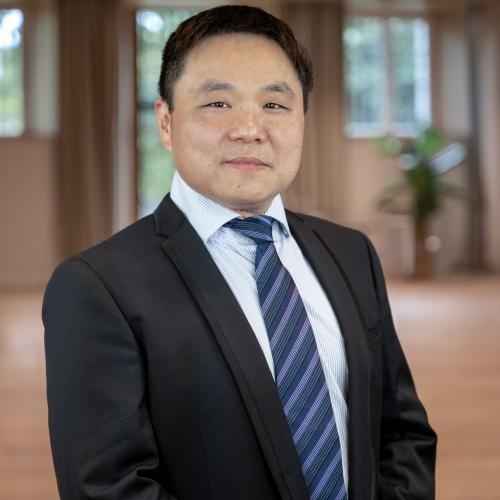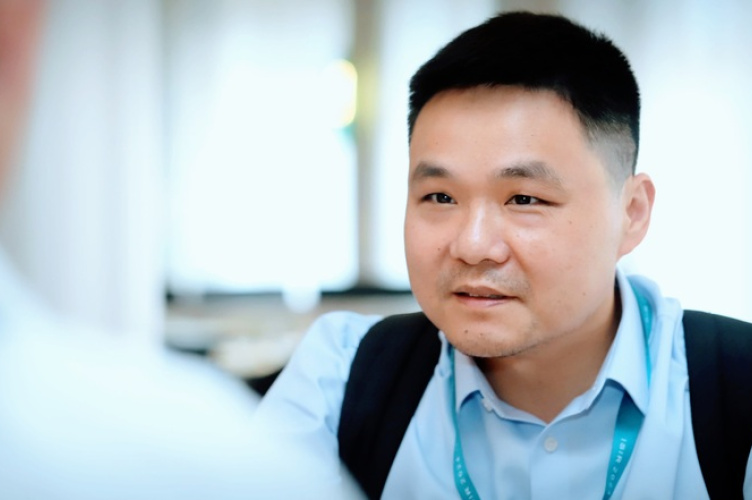Each morning, Professor Chuanwen Dong commutes to his office at ESCP using Berlin’s public transport system — half an hour on the bus, ten minutes on the metro. It’s a journey that mirrors the logic of his work: looking for a solution that balances efficiency, sustainability and interconnection, even if it takes a little longer.
I trained myself to use that time well, I read, I think, I try to make sense of things in my mind while my body is moving. That way, taking the bus becomes the win-win solution. Greener, and more productive.
 Chuanwen Dong
Chuanwen DongProfessor of Information & Operations Management
It’s a small choice, and also not so small. In conversation, Chuanwen speaks of trade-offs, not sacrifices. Riding the bus is, for him, an environmentally clean and economically sensible solution — one that reflects his broader philosophy: use what exists well, don’t rush towards novelty for its own sake, and look for the configuration — the system design — that quietly maximises value across dimensions. Cleaner, yes. But also mentally productive. A win-win solution, as he would say.
This is how Professor Dong thinks: in overlapping logics. His research spans sustainable supply chain design, corporate social responsibility, and AI adoption in large organisations — fields that don’t, at first glance, seem tightly bound. But in his work, and even more so in his thinking, they are.
He doesn’t make bold theoretical claims or speak in branding language. Instead, what emerges is a kind of conceptual humility — an engineer’s belief in rigour, and a sociological sense of systems as living things, full of tensions and externalities and irrational actors. His models may be mathematical, but his sensibility is ecological.
Designing towards the win-win
Dong’s academic journey began with a question posed by a company: how to reduce carbon emissions in logistics without incurring excessive costs? At the time, he was working at Procter & Gamble. He didn’t yet know that this question would mark the beginning of a new chapter in his life - from industry to academic, but the question stuck.
What emerged was a synchronised supply chain model that integrated emissions, cost, inventory, and production. It treated logistics not as a series of isolated decisions, but as one dynamic and holistic system — one that could be steered, gently, towards better outcomes.
“Many people try to optimise the problem itself, however, the solution also depends on the scope. When you zoom out, the answer changes. This is the system thinking.”
His doctoral work laid the groundwork for what would become his most recent article: a study on how small contractual shifts in the supply chain — especially between suppliers and downstream buyers — can nudge each other towards greener transport choices without compromising profitability. The model builds on his earlier thinking but moves into harder terrain: the challenge of decarbonising an entire supply chain, not just any single isolated operation within.
“It’s much easier to reduce emissions inside your own facilities,” he explains. “But once you try to change behaviour across your supply chain — upstream or downstream — that’s much harder.”
For Chuanwen, this is where many companies reach their limits — not because the intention isn’t there, but because the structure isn’t aligned to support it. His work suggests that better coordination, clearer incentives, and smarter contracts can begin to shift those boundaries.
“You don’t have to be an extreme cost-saver or an extreme decarboniser,” he says. “If you can get both, that’s the star solution.”
It’s here that Professor Dong’s thinking reveals its layered complexity. He builds like an engineer, searching for the optimal structure; he analyses like an economist, tracing incentives and constraints; and he sees like a sociologist, attuned to how behaviour, power, and systems shape each other. In another context, you could say he reasons like a policymaker — someone trained to look for solutions that work across institutions, not just inside one of them.
“There are more win-win zones than we think,” he says. “But we won’t find them if we only look at one part of the chain.”
The logic of platforms — and its limits
If AI is about internal transformation, platform economics, for Professor Dong, is about external consequences — and the moral lag that occurs when systems scale faster than their capacity for accountability.
In one of his most cited studies on platform economics, Chuanwen focuses on how two-sided platforms — like Uber, Airbnb, or Amazon — operate under very different business incentives than traditional firms. Their core objective is to grow the user base on both sides of the market, and early success depends on maximising scale.
“At the beginning, platforms just want to attract people,” Professor Dong explains. “They don’t necessarily care who joins, as long as the numbers go up.”
This growth-first approach can enable problematic actors — unvetted drivers, counterfeit sellers, exploitative intermediaries — but the priority is reach. As platforms mature and become household names, reputational risk begins to matter more.
Yet even that, Chuanwen suggests, may not be enough. “Once a platform becomes dominant, even scandals don’t hurt them the way they used to.”
In other words, the market’s own feedback mechanisms — such as user choice, media pressure, social outrage — begin to lose their disciplining effect when a platform reaches monopoly status. “The market can’t regulate itself once a monopoly is in place. That’s when governments have to step in. Not just with laws, but with actual enforcement.”
A systems thinker in motion
Despite the scale of the challenges he works on — climate breakdown, digital concentration, organisational inertia — Chuanwen remains, in his own words, “more optimistic.” Not because the problems are easy, but because structural change is possible. Not fast, and not flashy — but possible.
He points to the consumer goods industry as one area where alignment is already taking shape. Firms like Procter & Gamble, he notes, have begun integrating emissions goals not just into reporting, but into product design and supply chain planning. It's happening not out of pure altruism, but because it makes sense — economically, logistically, reputationally. “They can show a carbon-neutral shampoo,” he says, “and people respond. It’s real, and it works.”
At the same time, he adds, there’s still work to do. “If you track emissions across the full supply chain — from raw material extraction to consumer use — then we’re not there yet. But the industry is working hard on that and making solid progress.”
You don’t need to change everything all at once, but if you shift the structure a little, in the right place, something better starts to take shape.
And that, perhaps, is the thread that ties his work together: a belief that better systems don’t have to be invented from scratch. They can be built from within — through smarter contracts, better coordination, deeper awareness of the way decisions ripple across structures.
He still takes the bus each morning. Still reads, listens, thinks. Still looking, patiently, for the logic underneath things — and for the place where it might quietly bend towards something more sustainable, more intelligent, and more human.
Campuses
